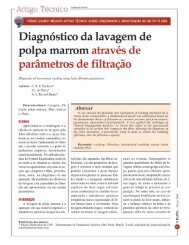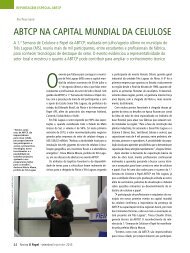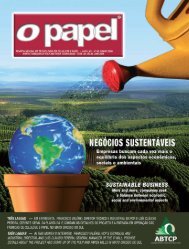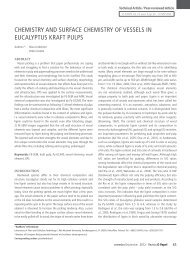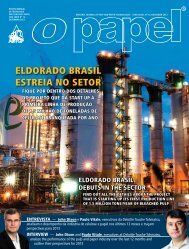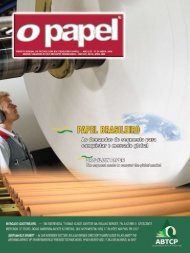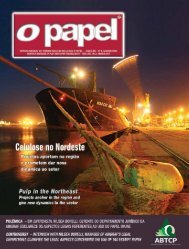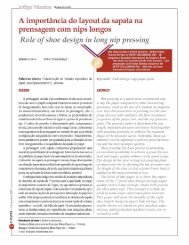Conhecimento é poder. - Revista O Papel
Conhecimento é poder. - Revista O Papel
Conhecimento é poder. - Revista O Papel
Create successful ePaper yourself
Turn your PDF publications into a flip-book with our unique Google optimized e-Paper software.
Artigo Técnico / Peer-reviewed Article<br />
O PAPEL vol. 72, num. 6, pp. 43 - 53 JUN 2011<br />
CONCLUSÕES<br />
Agitação de polpa branqueada de bambu a 900 rpm, temperatura<br />
ambiente e baixa consistência da massa (0,3%) durante estocagem de<br />
24 horas teve efeito negativo tanto na resistência das fibras quanto na<br />
da polpa. A densidade aparente diminuiu ligeiramente, mas a relação<br />
entre índice de tração e densidade aparente permaneceu inalterada. A<br />
estocagem sob agitação induziu torções nas fibras e aumentou o número<br />
de encurvamentos das fibras o que, por sua vez, resultou em menor<br />
resistência das fibras e da polpa. Contudo, a estocagem sem agitação<br />
teve impacto muito limitado nas propriedades de polpa e fibras.<br />
Este estudo tem primeiramente mostrado ser importante levar em<br />
consideração os efeitos da estocagem sob agitação quando celulose<br />
branqueada for preparada em laboratório ou em uma fábrica de celulose,<br />
pois estocagem sob agitação pode resultar em menor resistência<br />
da polpa. Em segundo lugar, foi observado que a classificação de polpas<br />
diferentes pode resultar incorreta se as polpas tiverem sido estocadas<br />
e agitadas antes de testadas. Finalmente, pode-se concluir ser importante<br />
que ao comparar polpas diferentes todas as amostras de polpa<br />
tenham tido o mesmo tempo de estocagem antes dos testes. •<br />
Agradecimentos<br />
Devemos agradecimentos à Eka Chemicals pelo suporte financeiro<br />
a Sanchuan Guo e pela realização de alguns dos ensaios, e a Marinette<br />
Grimbeek pela conversão linguística do manuscrito.<br />
CONCLUSIONS<br />
Agitation of a bleached bamboo pulp slurry at 900 rpm, room<br />
temperature and low pulp consistency (0.3%) during storage<br />
for 24 hours had a negative effect on both the fibre and the<br />
pulp strength. The apparent density decreased slightly, but the<br />
relationship between the tensile index and the apparent density<br />
remained unaffected. Agitated storage induced fibre kinks<br />
and increased the number of fibre curls which, in turn, led to<br />
lower fibre and lower pulp strength. However, non-agitated<br />
storage had a very limited impact on pulp and fibre properties.<br />
This study has firstly shown that it is important that the<br />
effects of agitated storage are taken into account when a<br />
bleached pulp is prepared in the laboratory or in a pulp mill,<br />
since agitated storage may lead to reduced pulp strength. Secondly,<br />
it has been noted that the ranking of different pulps can<br />
become erroneous if the pulps have been stored and agitated<br />
prior to testing. Finally, it can be concluded that if different<br />
pulps are being compared it is important that all pulp samples<br />
have had the same storage time prior to testing. •<br />
Acknowledgments<br />
Thanks are due to Eka Chemicals for financially supporting Sanchuan<br />
Guo and for performing some of the tests, and to Marinette<br />
Grimbeek for the linguistic reversion of the manuscript.<br />
Referências / References<br />
1. Jeyasingam, J.T. (1998). Practical experience on paper making with non-wood fibres. In: Proceedings of the Pulping Conference. Montreal,<br />
Quebec, Canada. Book 2, pp 767-774.<br />
2. Tang, H. (2005). Manufacture of bamboo fibre based high brightness writing paper. China Pulp and Paper, 24(1), pp 25-28.<br />
3. Zhao, G., Lai, R., Nilsson, J., et al. (2008). Some implications of an ECF bleaching sequence for bamboo fibre in the use of fine paper production. In:<br />
Proceedings of the 2 nd International Papermaking & Environment Conference, Tianjin, China, May 14-16, pp 598-602.<br />
4. Rydholm, S.A. (1985). Pulping Processes. Robert E. Krieger, Malabar, FL, pp 1122-1125.<br />
5. Sixta, H. (2006). Handbook of Pulp, Volume 2. WILEY-VCH, Weinheim, pp 1281-1284.<br />
6. Ek, M., Gellerstedt, G. & Henriksson, G. (2009). Pulp and Paper Chemistry and Technology, Volume 2, Pulping Chemistry and Technology.<br />
Walter de Gruyter, Berlin, pp 439-450.<br />
7. Paulapuro, H. (2000). Papermaking part 1, stock preparation and wet end. Chapter 4. Fapet, Helsinki, pp 87-121.<br />
8. Zhao G., Lai R., Nilsson J., He B. and Greschik T. (2008). Some implications of an ECF bleaching sequence for bamboo fiber in the use for fine paper<br />
production. 2th International Papermaking & Environment Conference, Tianjing, China, 14-16 May, pp. 598-602.<br />
9. Rao A.R.K., Srinivasan G, and Maheshwari H.K. (1978). Effect of beating on bamboo fibres. Indian Pulp and Paper, February-March, pp. 35-46.<br />
10. Wai N.N. and Murakami K. (1983). Characteristics of kraft pulp from Burmese bamboo. International symposium on wood pulping chemistry.<br />
Tsukuba Science City, Japan, May, pp. 188-193.<br />
11. Heijnesson-Hultén A., Basta J., Greschik T., Zhang C., Guo S. and Zhan, H. (2008). Influence of bleaching sequence on brightness stability,<br />
refining and chemical surface properties of kraft bamboo pulps. International Conference on Pulping, Papermaking and Biotechnology 2008,<br />
4-6 November, Nanjing, China, pp. 329-334.<br />
12. Heijnesson-Hultén, A., Guo , S., Basta, J., Greschik, . T., Zhan , Z. and Germgård , U. (2010). The effect of cooking to different kappa numbers on<br />
refining and paper sheet properties. In: Proceedings of 4 th International Symposium on Emerging Technologies of Pulping and Papermaking,<br />
Guangzhou, China, 8-10 Nov. pp. 729-733.<br />
13. Mohlin, U-B. (2010). Fibre properties and refining response for Scandinavian market softwood bleached kraft, Scientific and Technical Advances in<br />
Refining and Mechanical Pulping, Barcelona, Spain, 28 Feb.-4 Mar., Refining and mechanical pulping, Paper 8.<br />
14. Mohlin, U-B. (2010). Quality loss of refined softwood bleached kraft pulp during agitated storage. Nordic Pulp & Paper Res. J., 25(1), pp 76-81.<br />
15. Guo, S., Heijnesson-Hultén, A., Basta, J. et al. (2010). The influence of storage on bamboo pulps and paper quality. In: Proceedings of 4 th International<br />
Symposium on Emerging Technologies of Pulping and Papermaking, Guangzhou, China, 8-10 Nov.<br />
16. Greschik, T., Guo, S., Heijnesson-Hultén, A. et al. (2010). The effect of bamboo cooking to different kappa numbers on pulp quality after cooking<br />
and bleaching. 4 th ISETPP, Guangzhou, China, 8-10 Nov.<br />
17. Mohlin, U-B. & Alfredsson, C. (1990). Fibre deformation and its implications in pulp characterization. Nordic Pulp & Paper Res. J., 5(4). pp 172-179.<br />
18. Heijnesson-Hultén, A., Guo, S., Basta, J. et al. (2010). The effects on fibre and pulp properties when bamboo is cooked to different kappa numbers.<br />
In: Proceedings of 4 th International Symposium on Emerging Technologies of Pulping and Papermaking, Guangzhou, China, 8-10 Nov.<br />
junho/june 2011- <strong>Revista</strong> O <strong>Papel</strong><br />
53



